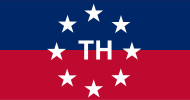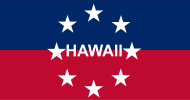William F. Quinn
| William F. Quinn | |
|---|---|
.jpg) | |
| 12th Territorial and 1st State Governor of Hawaii | |
|
In office August 21, 1959 – December 3, 1962 | |
| Lieutenant | James Kealoha |
| Preceded by | Himself (territorial) |
| Succeeded by | John A. Burns |
|
In office August 29, 1957 – August 21, 1959 | |
| Appointed by | Dwight D. Eisenhower |
| Preceded by | Samuel Wilder King |
| Succeeded by | Himself (state) |
| Personal details | |
| Born |
William Francis Quinn July 13, 1919 Rochester, New York |
| Died |
August 28, 2006 (aged 87) Honolulu, Hawaii |
| Resting place |
National Cemetery of the Pacific Honolulu, Hawaii |
| Political party | Republican |
| Spouse(s) | Nancy Ellen Witbeck |
| Children | 7 |
| Alma mater |
Saint Louis University Harvard Law School |
| Religion | Roman Catholicism |
| Military service | |
| Allegiance |
|
| Service/branch |
|
| Unit | Naval Intelligence |
| Battles/wars | World War II |
William Francis Quinn (July 13, 1919 – August 28, 2006) was the Governor of the Territory of Hawaii from 1957 to 1959 and the first Governor of the State of Hawaii from 1959 to 1962. Originally appointed to the office by President Dwight D. Eisenhower, Quinn was the last executive of an era of Republican rule over the Hawaiian Islands which began during the overthrow of the monarchy in 1893, and the last Republican to serve as governor until Linda Lingle in 2002. Quinn appeared as a guest panelist on the television program What's My Line.[1] He was the recipient of the Order of the Holy Sepulchre, a papal knighthood conferred by Pope John Paul II.
Early years
Quinn was born in Rochester, New York on July 13, 1919. His family moved to St. Louis, Missouri during his youth, where he attended prep school at St. Louis University High School and college at Saint Louis University, graduating in 1940. Quinn entered Harvard Law School, but only finished after his stint in the military. He graduated cum laude in 1947.[2] He served in Hawaii in naval intelligence during World War II. Upon his discharge from service, he settled permanently in Honolulu, Hawai'i.
Law and political career
In 1949, in a deal involving homestead development of the area of Waimea in Hawaii County, as a lawyer with Parker Ranch attorney Garner Anthony, Quinn brokered a deal with the Territorial Land Office and Hawaiian Homes Commission to allow the ranch a more lengthy period of time in which to evacuate the property.[3]
Quinn involved himself in territorial politics and ran for the Hawaii Territorial Senate in 1956.
Quinn worked closely with Congressional Delegate John A. Burns on the Hawaii Statehood Commission.[2][4] President Dwight D. Eisenhower appointed Quinn Governor of the Territory of Hawaii in 1957. In 1959, he defeated Burns to win the new state's first gubernatorial election.[5][6] In 1961, Governor Quinn was grand marshal of the Tournament of Roses Parade in Pasadena, California.[7] During the 1962 gubernatorial election, Quinn faced Burns in a rematch; a challenge from Lieutenant Governor James Kealoha split the vote, throwing the election to Burns.[8]
In 1976, Quinn ran for the United States Senate, an election he lost to Spark Matsunaga.[9]
Later years and personal life
Quinn married Nancy Ellen Witbeck and the couple had seven children.[2] They were members of the Portlock Road Association.
He was president of Dole Pineapple Company from 1965 to 1972, and chairman of the board of both the Honolulu Symphony and the East-West Center.[10]
Quinn lectured, occasionally traveled on the public speaking circuit serving as a Republican elder statesman, and spent time with his family in Hawai'i. A devout Catholic, he was the recipient of a papal knighthood in the Order of the Holy Sepulchre.
He was a dedicated actor and singer in the Honolulu Light Opera. His most notable role was in the 1940s production of Brigadoon.
In March 2006, Quinn was injured in a fall and never fully recovered. He died on August 28, 2006, and is buried at National Memorial Cemetery of the Pacific.
References
- ↑ What's My Line? - Dorothy Lamour; Martin Gabel (panel); Bob Crosby (panel) (Jul 13, 1958)
- 1 2 3 Hevesi, Dennis (ca August 2006). "William F. Quinn, 87, Governor Elected as Hawaii Became State, Is Dead". The New York Times. Check date values in:
|date=(help) - ↑ Bergin, Bill (2006). Loyal to the Land: The Legendary Parker Ranch, 1950-1970: Volume 2, The Senior Stewards. University of Hawaii Press. p. 97. ISBN 978-0-8248-3086-1.
- ↑ "Hawaii's Turn is Right Now". Life: 24. 21 July 1958.
- ↑ Chapin, Helen Geracimos (1996). Shaping History: The Role of Newspapers in Hawai'i. University of Hawaii Press. p. 238. ISBN 0-8248-1718-4.
- ↑ Holmes, T Michael (1994). The Specter of Communism in Hawaii. University of Hawaii Press;. p. 221. ISBN 978-0-8248-1550-9.
- ↑ "Grand Marshals of the Tournament of Roses Parade 1890 - 2005". Los Angeles Almanac. Retrieved 6 December 2010.
- ↑ Warren, Kenneth F (2008). Encyclopedia of U.S. Campaigns, Elections, and Electoral Behavior. Sage Publications, Inc. p. 296. ISBN 978-1-4129-5489-1.
- ↑ "William Francis Quinn". HawaiiHistory,org. Retrieved 6 December 2010.
- ↑ "In Memoriam". Harvard Law Bulletin. Retrieved 6 December 2010.
Further reading
- Richards, Mary C Kahulumana (1998). No Ordinary Man William Francis Quinn His Role in Hawaii's History. Hawaii Education Association. ISBN 978-0-9648963-2-1.
| Political offices | ||
|---|---|---|
| Preceded by Samuel Wilder King |
Governor of Hawaii 1957–1959 (territory) 1959–1962 (state) |
Succeeded by John A. Burns |

